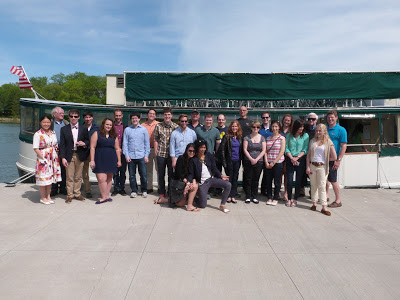Starting Up Field School 2.0
 |
| U R history graduates and the Mary Jemison |
It’s been a busy few weeks getting reading for the 2013
Smiths Island field school. When not replacing the front of my house (long
story), planning
a U of R graduating history major boat trip on the Erie Canal
(a real coup for a land-locked maritime historian!), and officiating at U of R’s
graduation, I’ve been gathering supplies for the dig, which commences next
week. My UR colleague Cynthia Ebinger has lent me a precision GPS so we can
firmly locate the many ruins and potential sites we found in 2010 but are not
currently georeferenced on any Bermudian maps - the venerable Lt. Savage’s otherwise
fantastic 1901 survey missed some fairly obvious inland Smiths Island sites –
like huge quarries – which suggests he didn’t actually come ashore! I’ve also been scrambling to obtain artifact
bags. The BNT-ARC emailed me that they’re all out, with too little time to
order any stateside. Luckily, Wegmans (my fantastic local supermarket) came
through by selling me bags from their candy department – at the price per pound
of their candy!  |
| St. George's from the air: if you have a choice, pick a window seat on the right side of the plane when flying to Bermuda! |
And there will be many more than just the five of us. Thanks
to the newspaper article in the Bermuda Sun (http://bermudasun.bm/Content/NEWS/Environment/Article/Was-this-the-first-Bermuda-home-/24/898/65774)
and the Bermuda National Trust’s call for volunteers, we have at least fifteen
other people interested in digging with us, ranging from retired couples to
teenagers who have been volunteered by their mothers...
I really am looking
forward to helping Bermudians learn about and unearth their own past. An
important but often overlooked part of historical archaeology is engaging and
involving the public to promote awareness of the fragility of our cultural heritage
and to diversify the range of people included in histories beyond white
property-owning men who make up the bulk of those documented in surviving
records. With luck, we will find evidence of enslaved Native Americans, black
Bermudian slaves who seasonally worked in the whale house, the three poor
English sailors who became the First Bermudians, and the unknown individuals who were forced to
stay at the island’s quarantine station and those who nursed them in their
illness. I can’t wait to get started!

.jpg)
Comments